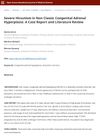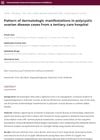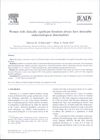To Evaluate Frequency of Hirsutism in Afghan Women
May 2018
in “
Journal of Saidu Medical College Swat
”
TLDR Hirsutism in Afghan women varies by community, influenced by awareness, education, and socio-economic status.
The study aimed to determine the frequency of hirsutism in Afghan women attending the Gynecology OPD at Khyber Teaching Hospital, Peshawar, over two years. Out of approximately 1,500 patients, 50 were found to have varying degrees of hirsutism, with most presenting additional gynecological issues like oligomenorrhea and infertility. Polycystic Ovarian Disease was prevalent in 58% of cases, and elevated testosterone levels were observed in 17 patients. The study concluded that the incidence of hirsutism varied due to factors like disease awareness, education, and socio-economic status, with most cases being idiopathic and adrenal causes being rare.






